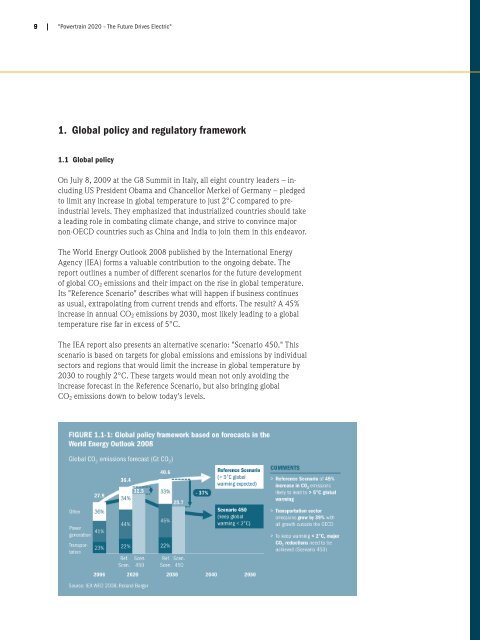Powertrain 2020 - The Future Drives Electric (PDF ... - Roland Berger
Powertrain 2020 - The Future Drives Electric (PDF ... - Roland Berger
Powertrain 2020 - The Future Drives Electric (PDF ... - Roland Berger
You also want an ePaper? Increase the reach of your titles
YUMPU automatically turns print PDFs into web optimized ePapers that Google loves.
9 |<br />
"<strong>Powertrain</strong> <strong>2020</strong> – <strong>The</strong> <strong>Future</strong> <strong>Drives</strong> <strong>Electric</strong>"<br />
1. Global policy and regulatory framework<br />
1.1 Global policy<br />
On July 8, 2009 at the G8 Summit in Italy, all eight country leaders – including<br />
US President Obama and Chancellor Merkel of Germany – pledged<br />
to limit any increase in global temperature to just 2°C compared to preindustrial<br />
levels. <strong>The</strong>y emphasized that industrialized countries should take<br />
a leading role in combating climate change, and strive to convince major<br />
non-OECD countries such as China and India to join them in this endeavor.<br />
<strong>The</strong> World Energy Outlook 2008 published by the International Energy<br />
Agency (IEA) forms a valuable contribution to the ongoing debate. <strong>The</strong><br />
report outlines a number of different scenarios for the future development<br />
of global CO 2 emissions and their impact on the rise in global temperature.<br />
Its "Reference Scenario" describes what will happen if business continues<br />
as usual, extrapolating from current trends and efforts. <strong>The</strong> result? A 45%<br />
increase in annual CO 2 emissions by 2030, most likely leading to a global<br />
temperature rise far in excess of 5°C.<br />
<strong>The</strong> IEA report also presents an alternative scenario: "Scenario 450." This<br />
scenario is based on targets for global emissions and emissions by individual<br />
sectors and regions that would limit the increase in global temperature by<br />
2030 to roughly 2°C. <strong>The</strong>se targets would mean not only avoiding the<br />
increase forecast in the Reference Scenario, but also bringing global<br />
CO 2 emissions down to below today's levels.

















